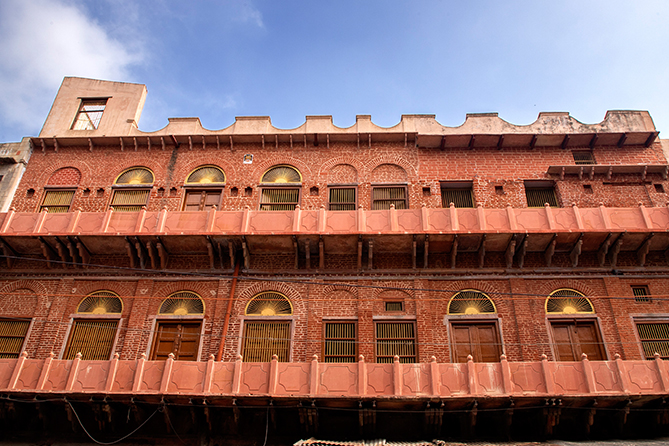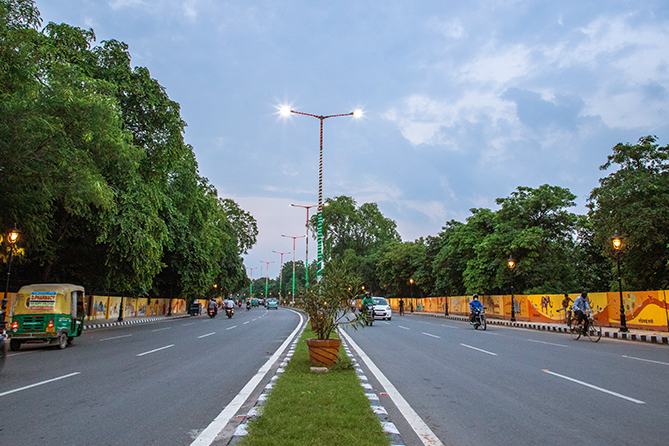SWOT Analysis
SWOT Analysis




Agra has unique strengths as a hub for tourism and craft manufacturing, but needs to create infrastructure, experiences, livelihood opportunities, and green initiatives to improve citizen and tourist experience
Strengths of Agra
- Boasts of 48 ASI protected monuments, including two World Heritage sites the Taj Mahal – one of the Seven Wonders of the World – and the Agra Fort.
- Important node on the golden triangle tourist circuit (Jaipur-Delhi-Agra).
- Highest foreign tourist footfall in the country – attracts 17% of total foreign tourists (nearly 11.5 lakh) visiting India. The Taj Mahal alone attracts 7-8 million domestic and foreign visitors.
- Connected by India’s fastest train yet, Gatimaan Express (Delhi to Agra in 100 minutes)
- Local craftsmanship in inlay work, leather-ware, embroidery, zardosi weaving and jewelry making is famous.
- Renowned for leather shoes and is the largest shoe manufacturing hub in the country.
- Pioneer in providing tech-savvy services for citizens
- App to lodge complaints of locations where waste has not been collected;
- Mobile app for locating toilets;
- App to monitor sanitation workers and track SWM vehicles.
- Pioneer in water treatment technology: MBBR technology-based water treatment technology, first of its kind in the country.
- Pioneer in eco-friendly initiatives: Banned use of plastics through Polythene-free Agra initiative.
- Strong healthcare infrastructure: Available hospital beds per 1000 population is 5, which is superior to the national average of 0.9 beds per 1000 population.
Weaknesses of Agra
- Absence of cultural and entertainment activities to engage tourists.
- Fading aesthetic appeal of monuments post-sunset due to poor/no lighting.
- Deteriorating conditions of the lesser known monuments.
- Unpleasant touring experience due to extreme weather – summer temperature soars as high as 48 degree Celsius, while winter temperature goes as lowe as 4 degree Celsius.
- Poor water management characterized by high NRW (40%) and lower per capita supply of water (91 LPCD).
- Poor hygiene and sanitation:
- Absence of D2D collection. Municipal waste is collected from community-bins and is disposed at the landfill.
- Only 13/90 wards declared as open-defecation-free wards.
- Lack of walkable footpaths and other pedestrian infrastructure and only 4% share of public transport.
- One of the highest road accident fatality rate in the country – 41 persons per lakh population.
- Share of public transport is mere 4%.
- Economy of the city is heavily dependent on tourism which is subject to business cycles and global economic scenarios.
Opportunities for Agra
- Improving infrastructure to boost employment and revenue:
- For every direct job created in tourism, 4.62 (job multiplier) other jobs are generated in ancillary areas.
- For every rupee spent on a tourism activity, generates INR 2.07 (revenue multiplier spending down the line).
- Creating a Heritage-tourism hub:
- Reviving and promoting lesser known monuments to create additional tourist destinations.
- Organizing heritage walks around the lesser known monuments
- Increasing the frequency of events such as Taj Mahotsav, hot air balloon festival, Ganga Dassera, etc.
- Organizing formal factory tours for petha-making, inlay carving, zardosi weaving, etc.
- Using the brand ‘Agra’, developing merchandise such as t-shirts, mugs, etc.
- Hosting international events at the existing golf-course
- Leveraging on Intelligent Transport Management Systems (ITMS) to decongest and improve road safety, thus improving intra-city tourist mobility.
- Action on proposed government initiatives to promote tourism:
- Regional eco-tourism integration of ravines along River Yamuna with National Chambal Sanctuary (crocodile sanctuary), Sur Sarovar Bird Sanctuary in Keetham, Elephant and Bear Rescue Centre, Keoladeo Bird Sanctuary in Bharatpur, and proposed lion safari at Etawah, along with Bateshwar.
- Developing a tourism hub along the on-going and proposed project of U.P. Tourism Department – Mughal Museum, Orientation Centre, International Café – and the proposed project of ADA – Sports Stadium.
- Development of Theme Park as proposed in ADA master plan for corridor development along inner-ring road.
- Acting upon the approval to expand the terminal at Kheria airport and enabling policies to provide speedy licenses to commercial airlines, thus improving connectivity.
- Enhancing existing art-pool skills
- Developing organised markets for existing small scale industries engaged in stone inlay, zardosi weaving, embroidery, marble sculpting, leather-ware.
- Developing skill-based (craftsmanship) education institute.
- Developing agriculture
- Developing food parks and agro-processing industries which will have backward linkage from hospitality sector.
- Improving infrastructure to boost employment and revenue:
Threats for Agra
- Pollution generated upstream of River Yamuna can degrade the environmental condition of the city, and deteriorate monuments.
- High security/terrorism concerns as Taj Mahal is an international destination.
- Poor quality of life and living conditions can be detrimental to tourist’s influx.
- Sensitivity to global economic scenarios – high dependence on foreign tourism may negatively impact the city’s economy in case of a worldwide economic slump
